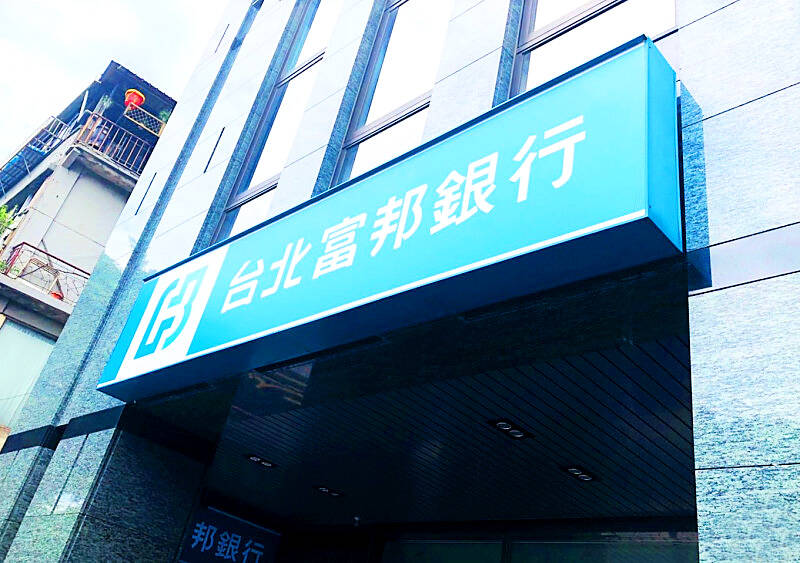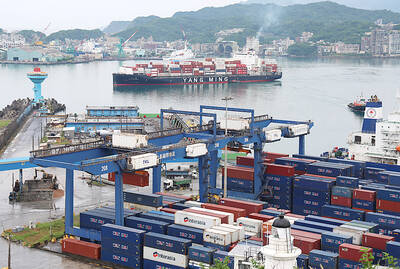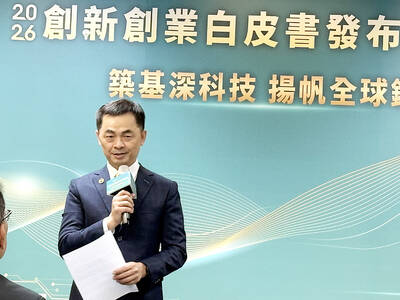The Financial Supervisory Commission yesterday approved Taipei Fubon Commercial Bank’s (台北富邦商業銀行) application to set up a Japanese branch.
This follows its approval in February of Taiwan Cooperative Bank’s (合庫銀行) application to establish a branch in the East Asian nation.
In a statement posted on its Web site, the commission said it had green lighted Taipei Fubon Bank’s application to seek approval from financial authorities in Japan to open a branch in Tokyo in light of the Japanese market’s growth prospects and the bank’s overseas deployment needs.

Photo: Kelson Wang, Taipei Times
“Taipei Fubon Bank considers Japan as one of the world’s major economies and it has close bilateral trade exchanges with Taiwan,” the commission said in the statement. “The bank plans to establish a Tokyo branch to extend its financial services to Japan and gradually complete building up its overseas network.”
As of the end of last year, the bank — a subsidiary of Fubon Financial Holding Co (富邦金控) — had eight overseas units in Vietnam, Hong Kong, mainland China, Singapore, Indonesia and Australia. They include one subsidiary, five branches and two representative offices, data from the bank showed.
Apart from opening a branch in Tokyo, the bank also plans to establish a branch in Mumbai, India, and a representative office in Seoul to expand its overseas operations and create multiple profit sources, it said in a separate statement.
Fubon Financial leads its local peers as the most profitable financial institution in Taiwan, posting a net profit of NT$59.43 billion (US$1.82 billion) in the first five months of this year, or earnings per share of NT$4.57.
Taipei Fubon Bank also posted a record-high net profit of NT$13.24 billion in the first five months, up 26 percent year-on-year, company data showed.
The bank is to become the latest to tap the Japanese market to help Taiwanese businesses and local Japanese enterprises access financing opportunities, amid growing bilateral trade exchanges and the regionalization trend of global supply chains.
It also comes as a shift in banks’ appetite for the Japanese market following Taiwan Semiconductor Manufacturing Co’s (TSMC, 台積電) launch of new wafer fabs in Kumamoto Prefecture early this year.
“TSMC has launched a new fab in Kumamoto and is driving dozens of its supply-chain firms to set up factories in Japan, which is conducive to expanding the base of Taiwanese customers there,” the bank said in the statement.
The world’s largest contract chipmaker is planning to build a second fab near the first one, with operations scheduled to begin by the end of 2027.
“Japan looks to offer great investment opportunities and the corresponding financial prospects are promising,” the bank added.
So far, eight Taiwanese banks operate a total of 10 branches and one subsidiary in Japan, most of which are in Tokyo while the others are in Osaka and Fukuoka, the commission said.
The eight are Bank of Taiwan (臺灣銀行), First Commercial Bank (第一商業銀行), Chang Hwa Commercial Bank (彰化商業銀行), Mega International Commercial Bank (兆豐國際商業銀行), Taiwan Business Bank (臺灣中小企業銀行), E.Sun Commercial Bank (玉山商業銀行), Taishin International Commercial Bank (台新國際商業銀行) and CTBC Bank (中國信託商業銀行).
The combined pre-tax profit of Taiwanese banks’ Japanese units totaled NT$990 million in the first quarter of this year, up 54.4 percent from NT$640 million in the same period last year, data released by the commission in May showed.
Bilateral trade between Taiwan and Japan totaled US$75.8 billion last year, with Taiwan being Japan’s fourth-largest trading partner and Japan being Taiwan’s third-largest trading partner and the fourth-largest source of foreign investment, government data showed.

CHIP RACE: Three years of overbroad export controls drove foreign competitors to pursue their own AI chips, and ‘cost US taxpayers billions of dollars,’ Nvidia said China has figured out the US strategy for allowing it to buy Nvidia Corp’s H200s and is rejecting the artificial intelligence (AI) chip in favor of domestically developed semiconductors, White House AI adviser David Sacks said, citing news reports. US President Donald Trump on Monday said that he would allow shipments of Nvidia’s H200 chips to China, part of an administration effort backed by Sacks to challenge Chinese tech champions such as Huawei Technologies Co (華為) by bringing US competition to their home market. On Friday, Sacks signaled that he was uncertain about whether that approach would work. “They’re rejecting our chips,” Sacks

Taiwan’s exports soared 56 percent year-on-year to an all-time high of US$64.05 billion last month, propelled by surging global demand for artificial intelligence (AI), high-performance computing and cloud service infrastructure, the Ministry of Finance said yesterday. Department of Statistics Director-General Beatrice Tsai (蔡美娜) called the figure an unexpected upside surprise, citing a wave of technology orders from overseas customers alongside the usual year-end shopping season for technology products. Growth is likely to remain strong this month, she said, projecting a 40 percent to 45 percent expansion on an annual basis. The outperformance could prompt the Directorate-General of Budget, Accounting and

NATIONAL SECURITY: Intel’s testing of ACM tools despite US government control ‘highlights egregious gaps in US technology protection policies,’ a former official said Chipmaker Intel Corp has tested chipmaking tools this year from a toolmaker with deep roots in China and two overseas units that were targeted by US sanctions, according to two sources with direct knowledge of the matter. Intel, which fended off calls for its CEO’s resignation from US President Donald Trump in August over his alleged ties to China, got the tools from ACM Research Inc, a Fremont, California-based producer of chipmaking equipment. Two of ACM’s units, based in Shanghai and South Korea, were among a number of firms barred last year from receiving US technology over claims they have

BARRIERS: Gudeng’s chairman said it was unlikely that the US could replicate Taiwan’s science parks in Arizona, given its strict immigration policies and cultural differences Gudeng Precision Industrial Co (家登), which supplies wafer pods to the world’s major semiconductor firms, yesterday said it is in no rush to set up production in the US due to high costs. The company supplies its customers through a warehouse in Arizona jointly operated by TSS Holdings Ltd (德鑫控股), a joint holding of Gudeng and 17 Taiwanese firms in the semiconductor supply chain, including specialty plastic compounds producer Nytex Composites Co (耐特) and automated material handling system supplier Symtek Automation Asia Co (迅得). While the company has long been exploring the feasibility of setting up production in the US to address